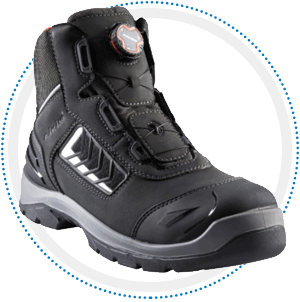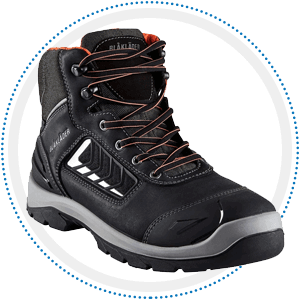Safety Boots & Shoes
Safety footwear has been designed to protect your feet from any hazards or obstacles you might face at work that could result in a foot related injury. The PPE must fulfil the requirements in line with European standards which ensures the footwear has been tested correctly and has certain properties which must be adhered to. In this guide, we will talk about:
📝 Chapter 1:
Let's Start with This: Safety Boots vs Safety Shoes?
Generally, a lighter safety shoe is ideal for those working in shops, warehouses, healthcare and for office workers who occasionally need to go to higher risk areas. A work boot is suitable for those working in the construction industry or environments where cement and other irritants are present. Check out our high-quality safety footwear brands:
SAFETY BOOTS
Boots cover not only the feet but also the ankles and sometimes the lower leg, so have better weather protection to keep your feet warm and dry. They also offer higher ankle support, helping guard against ankle twists and sprains, as well as cuts, scrapes and bangs. If you need wide fitting boots, you might be interested in some of the Wide Fit Safety Boots below with wider and deeper toecaps to give extra room for wide feet. See the following Mens / Womens Safety Boots (Women’s last in sizes 35-39)
SAFETY SHOES
Shoes cover and protect the feet and generally stay below the ankles. They are lightweight and not as heavy as safety boots, enabling you to move faster at work. Many safety shoes have a high level of protection such as midsole penetration resistance, heat resistance, antistatic protection and water penetration & absorption prevention. Wide safety shoes available. See the following Safety Shoes for Men / Women (Women’s last in sizes 35-39)
📝 Chapter 2:
Toe Cap Material: Composite vs Steel Toe
SIMILARITY: Are composite toe caps as safe as steel? Both will have the same safety footwear standards across the board and so either is suitable for general work. You will not compromise on safety on job site.
DIFFERENCE: While they both can meet the EN safety regulation basic requirements of toe protection, composite toe cap safety boots/shoes are not able to withstand the same level of impact as a steel toe boot. It means steel toe cap footwear offers a higher level of protection. Check the table below to find out their differences:
| Composite toe caps | Steel toe caps |
| Kevlar, carbon, plastic or fiberglass | Steel |
| 30% Lighter | Heavier |
| Less puncture resistance | High puncture resistance |
| More expensive | Cheaper |
| More comfortable & breathable | Less comfortable & breathable |
| Do not set off metal detectors | Set off metal detectors |
| Do not conduct heat or cold | Conduct heat or cold |
So, you will need to choose composite toe footwear if you
- pass through metal detectors frequently
- work in extreme temperatures (encounter cold/heat)
- work around electricity without the need of utmost toe protection, e.g. electricians and engineers.
- popular picks: S3 lightwight safety shoes
But, steel toe footwear will be better for you if you
- work with heavy objects and carry them around, e.g. warehousing jobs
- have a higher risk of injury to toes or feet, e.g. heavy items stored overhead
- popular picks: steel toe boots (S3) and 6'' steel toe SB boots
📝 Chapter 3:
S1, S2, S3 Safety Boots/Shoes: What Safety Features Does Each Have?
How to choose the right safety rating for your work boots and shoes? Let's skip lengthy explanation and start with this easy-to-read table.
| EN ISO 20345:2011 | SB | S1 | S2 | S3 | S4 | S5 |
| Basic Protection: (Toe protection, Slip resistance, Outsole strength, Upper tensile Strength etc) |
✓ | ✓ | ✓ | ✓ | ✓ | ✓ |
| Antistatic properties | ✓ | ✓ | ✓ | ✓ | ✓ | |
| Resistance to fuel oil | ✓ | ✓ | ✓ | ✓ | ✓ | |
| Energy absorption of seat region (in heel) | ✓ | ✓ | ✓ | ✓ | ✓ | |
| Closed seat region (fully enclosed heel) | ✓ | ✓ | ✓ | ✓ | ✓ | |
| Water penetration & absorption prevention | ✓ | ✓ | ||||
| Midsole penetration resistance | ✓ | ✓ | ||||
| Cleated Outsole | ✓ | ✓ | ||||
| Waterproofness & leakproofness | ✓ | ✓ |
- Basic toe protection: Offer protection against a 200-joule impact & 15kN compression force
- Antistatic protection: Prevent electrostatic build-up and ensure it is discharged effectively. This is essential to eliminate the risk of electric shock from electrical equipment or live parts as well as that posed by sparks igniting flammable substances or vapours.
- Resistance to fuel oil: Ensure the working life of the boot won't be compromised if used in oily environments.
- Energy absorption in the heel: Prevent injuries that occur through impact loading to the foot in daily activities such as jumping, running or and even walking.
- Fully-enclosed heel: The seat region (heel) is enclosed meaning no holes other than to form seams.
- Water penetration & absorption prevention: Keep you dry.
- Midsole penetration resistance: Guard against nails and other sharp objects, preventing them from piercing through the sole
- Cleated Outsole (protrusions on the sole): Provide additional traction on a soft or slippery surface
- Waterproofness & leakproofness: Made out of a vinyl or rubber based material, not letting any water in and out such as wellington boots
DIFFERENT CLASSES OF SAFETY SHOES & BOOTS
📝 Chapter 4:
Safety Footwear Codes Explained: Which is the best for your work?
| SRA slip resistant soles: Tested on a ceramic tile wetted with dilute soap solution. | SRC slip resistant soles: Offer the highest slip resistance protection as they pass both SRA and SRB slip resistance tests. |
| P: Midsole Penetration Protection (Resist penetration force of 1100N) | WR: Water Resistance |
| C: Conductive | M: Metatarsal Protection |
| A: Antistatic Protection | AN: Ankle Protection |
| I: Electricity Insulating Footwear | CR: Cut Resistant Upper |
| E: Energy Absorption in the heel region | WRU: Water Resistant Upper |
| HI: Insulation Against Heat (Tested for 30 minutes at 150°C) | HRO: Heat Resistant Outsole (Resist 300°C for 60 seconds) |
| CI: Insulation Against Cold (Tested for 30 minutes at -20°C) | FO: Fuel Oil-Resistant Outsole |
Now, you should understand how protective a pair of safety shoes is by looking at their ratings. For example, if you see a shoe is rated as below, it means it offers all-round protection of the highest safety level (i.e. S5), together with great insulation against the cold (i.e. CI) and highest slip resistance protection (i.e. SRC). It is usually for winter safety boots.
EN ISO 20345:2011 S5 CI SRC
Here is another example. The standard below means the footwear features a heat resistant outsole that resists 300°C for 60 seconds (i.e. HRO), together with great insulation against heat (i.e. HI) and slip resistance protection (i.e. SRA). It is usually for welding boots.
EN ISO 20345:2011 S2 P HRO HI SRA
📝 Chapter 5:
How to Do Shoe Care?
Even the toughest and the most expensive footwear experience wear and tear. But without proper care, this can be even faster and worse. We want to provide you with shoe care tips so that you can enjoy a safe pair of shoes/boots from MTN SHOP for as long as possible.
✓ Use two different pairs: Allow one pair to rest and release moisture before they are put to work, extending the life span of both pairs.
✓ Maintain clean workspace: Check to see whether you can keep your workspace clean and free from additional dangers because clean workspace = clean shoes
✓ Dry shoes properly: Loosen the tongue and the laces. Remove the insole and stuff the shoe with newspaper.
✓ Use shoe wax or cream: Prevent dirts from sticking
✓ Store shoes safely: Place your shoes in a box or shoe bag but not a plastic bag because it provides the perfect conditions for mould to form
✘ Do not machine wash: This can destroy the outer materials and safety features.
✘ Do not make changes to your shoes: Using any foreign parts such as insoles can quickly lose their protective properties if unsuitable parts are used.
✘ Do not dry shoes in the sun or using a heat source: This makes leather quickly turn hard and brittle.
📝 Chapter 6:
FAQs about Safety Boots & Shoes
What does composite toe cap mean?
Composite toe caps, usually made of materials such fibreglass, kevlar or carbon fibre, are usually lighter than steel boots and are completely metal free and therefore do not conduct electricity.
Metatarsal Boots vs Steel Toe Boots: Which footwear is suitable for you?
Metatarsal guards will protect your entire toe and metatarsal area which are very vulnerable to injury, while steel toe footwear will only protect your toe area. So, if you want to protect your entire feet from any possible sort of injuries, you should definitely go for the metatarsal guards.
How to Clean Smelly Work Boots?
Take some baking soda and sprinkle it on your footwear. For good results, it should be allowed to sit overnight. You can also try to apply some baby powder on the feet before putting on the socks on a regular basis.
How to Break in Steel Toe Work Boots?
Work boots will take more effort to break in than regular boots because the leather is harder so your feet can easily get hurt if you head to work with boots that haven’t been broken in. Start by wearing your new boots around the house for a few hours a day to make the leather flex into the shape of your foot.
Aluminum Toe Boots vs Steel Toe Boots - Which are better?
Aluminum toe is made from light materials while steel material is heavier. When it comes to insulation, aluminum toe has done a greater job, making your feet comfortable in cold weather. However, Aluminium toe boots are usually more expensive.















